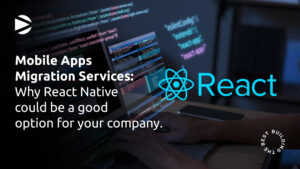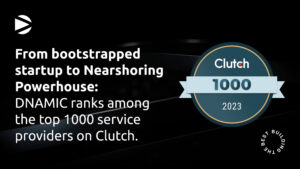What is Low-Code / No-Code
In the early days of computing, developers wrote code to create software. But over time, development tools and methods evolved to make it possible for people without prior coding skills to develop software. Some people call no-code the latest IT trend, but is this just a repackaging of older technologies? A trend that’s selling more than it gives? This blog post will look at no-code development and compare it to traditional programming.
No-code platforms allow you to create applications with little coding experience, making them perfect for entrepreneurs, designers, or business owners who want to create their applications but don’t have the time or skills to code.
They’re ideal for prototyping new ideas quickly and easily. So if you’re looking for an easy way to get your feet wet in the world of application development, no-code might be just what you need.
Low-code – No-code (LCNC) platforms are all the rage in the IT world. But what is no-code, and why is it such a big deal?
What makes LCNC valuable?
The ease and availability of cloud computing systems shorten development times by providing access from anywhere there’s an internet connection; this means less spending on hardware installation costs and increasing productivity instead!
More businesses rely heavily on data analysis to achieve their goals within operational efficiency brackets. The value LCNC brings is in both its economic and intellectual strength for companies.
On one hand, they can access an untapped market by using their knowledge to encode it with technology which helps them focus on higher-value activities. Simultaneously, these technologies will boost developers’ adoption rates, improve productivity, faster completion time (TAT), and so on, resulting in greater output.
LCNC tools are for any organization size that needs to digitize its processes. The confluence of rising IT needs (80% feel they need more technical support) and scarcity of developers has created an increasing desire for DIY technologies. These tools can also be implemented at a reduced capital cost and provide the ability to scale up or down as needed, making it possible for businesses of all sizes to take advantage of this technology.
Technology these days
Low-code and no-code platforms are to dominate the technology landscape in the future. Low-code platforms are excellent for prototyping new concepts, whereas no-code platforms are ideal for developing unique applications quickly.
Time is gold.
The landscape of the LCNC industry is diverse and complex. It goes from social media platforms like email drags, drop campaigns, advertising networks, and digital services such as website hosting services or payment processing providers.
However, through our analysis, we were able to identify nine categories that group many companies in this space together:
01
Business Intelligence
Business intelligence (BI) is the process of collecting, analyzing, and reporting on data to help businesses make better decisions. BI tools can help companies track customer behavior, forecast sales, and identify trends.
02
Customer Service / CRM
Customer service and CRM (customer relationship management) software help businesses manage customer interactions and track customer data. CRM software can track customer purchases, contact information, complaints, and more.
03
Enterprise Application Development
Enterprise application development (EAD) is the process of customizing and integrating existing software programs to meet a business’s needs through creative programming. This innovative programming can save companies money by building apps from scratch instead of buying expensive software licenses from third-party vendors.
04
IoT / Industrial automation
Industrial automation refers to technologies designed to control machines, processes, and systems without human intervention. Industrial automation spans robotics, process control, manufacturing, and energy production.
Some of these tools allow businesses to monitor activity in real-time and track data across machines or processes.
05
Machine Learning
06
Marketing,
E-Commerce, Design Tools
Marketing tools let companies manage their online presence and create marketing campaigns on social media, websites, and email lists.
These are key for our current social market.
E-commerce solutions allow businesses to drive sales, track inventory, and process payments. At the same time, design tools offer creative abilities for companies, allowing them to create new innovative content or modify creative elements of their marketing campaigns.
Many LCNC add e-commerce and design tools such as Hubspot, Squarespace, Shopify, Adobe CQ5, or even Canva to help them reach their goals.
07
Software Development Tools
08
Web App Development
Web applications create websites that support user interaction and work in any browser.
LCNC web apps often require programming but do not need the same level of security as programs running on the computer’s hard drive. These spaces allow users to be creative with their websites without writing code from scratch.
09
Workflow Automation
The future:
Investment and Market Value
After learning or adapting to a few of the nine technologies mentioned, significant changes have occurred in all major industries, showing a large amount of funding has gone into LCNC firms. Over 30 enterprises have received $7.5 billion in total investment, 20 of them valued at more than $158 billion combined!
When it comes to public or enterprise values, 17 companies stand out. These include giants like Microsoft and Amazon and dedicated LCNCs such as ServiceNow and UI Path Appian.
The market is snowballing with increasing demand for low-code and no-code platforms. In the third quarter of 2017, Forrester reported that “demand for low-code/no-code app development platforms is rising as users find these tools help them quickly create apps to solve business problems.”
No-code: yes or no?
The no-code development movement has had a significant impact on the digital industry and the future as we know it. It makes it possible for businesses to create digital products without hiring a data science team or learning how to code, which, as we mentioned, is cheaper and quicker.
The future of software development is looking bright, with low-code and no-code platforms gaining traction in the market. The movement has brought new opportunities for businesses in all types of industries, making the importance of quality software more essential than ever before.


